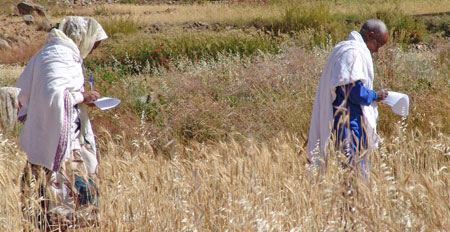There is plenty of analysis out there on the topic of agricultural subsidies and their actual or potential effect on things like growth of the farm sector, productivity, rural population levels and employment rates, farmers’ incomes and the number and average size of farms. But I haven’t seen much empirical data – or even theoretical discussion – of what subsidies (or the lack of them) mean for agrobiodiversity on farms. The data and discussion must be out there, it’s just that I don’t know the agricultural economics literature well enough to even know where to look.
So it was kind of interesting that I happened across two pieces of work in the past couple of weeks that shed some – albeit oblique – light on the subject. A 2003 article on The New Farm looks at what happened in New Zealand when agricultural subsidies were phased out: starting in 1984, the kiwis kept “a basic social security framework … funding for agricultural research, … and measures to keep agricultural pests from leaping around the world, and (did) away with the rest.â€Â
The New Zealand experience strongly suggests that most supposed objectives of agricultural subsidies and market protections – to maintain a traditional countryside, protect the environment, ensure food security, combat food scarcity, support family farms and slow corporate take-over of agriculture – are better achieved by their absence.
The paper suggests that the end of subsidies forced farmers to diversify, embrace organic methods, let marginal land revert to bush and innovate furiously, including by adopting new varieties. It’s hard to be entirely sure from the information presented, but on balance it would seem that (agricultural) biodiversity was better conserved and better used after subsidies ended.
I also came across a newly-released FAO paper entitled “Long Term Farming Trends. An Inquiry Using Agricultural Censuses,†a meta-analysis of 43 agricultural censuses across 17 countries. The authors look at differences among countries, and changes in the last 30 years or so, in things like land inequality and farm size, but also crop diversification, by which they basically mean the extent to which non-staple crops are being grown. They found, for example, that small farms tend to concentrate on staple crops more than bigger farms do, and that agricultural openness (i.e. lack of subsidies) “is correlated with diversification away from staple crops.†Though this relationship did not hold for countries with high population levels, the result concords with what happened in New Zealand.
You see what I mean when I said that the light being shed is at best oblique. Neither paper discusses diversity within crops much (or at all!), and their concept of “diversification†was somewhat crude. That wasn’t really their aim, so you can’t blame the authors. But with WTO members discussing the freeing up of agricultural markets (when they manage to discuss anything at all), I do wonder whether agricultural economists are devoting enough (or any) thinking to the possible effects on agricultural biodiversity. I look forward to being reassured by someone out there.


 Hanfets, which is also common also in Tigray, the most northern region of Ethiopia, is a highly sophisticated way to cope with the very unpredictable nature of dry lands that will become increasingly more unpredictable with climate change: wet years favour the higher yield potential of wheat, dry years favour the better drought tolerance of barley, the incidence of diseases (particularly rusts in wheat) is reduced, and, as farmers claim, the bread (Kitcha) made out of the mixture tastes much better (and is more digestible) than wheat or barley bread. Pictured left, Professor Woldeamlak Araia
Hanfets, which is also common also in Tigray, the most northern region of Ethiopia, is a highly sophisticated way to cope with the very unpredictable nature of dry lands that will become increasingly more unpredictable with climate change: wet years favour the higher yield potential of wheat, dry years favour the better drought tolerance of barley, the incidence of diseases (particularly rusts in wheat) is reduced, and, as farmers claim, the bread (Kitcha) made out of the mixture tastes much better (and is more digestible) than wheat or barley bread. Pictured left, Professor Woldeamlak Araia